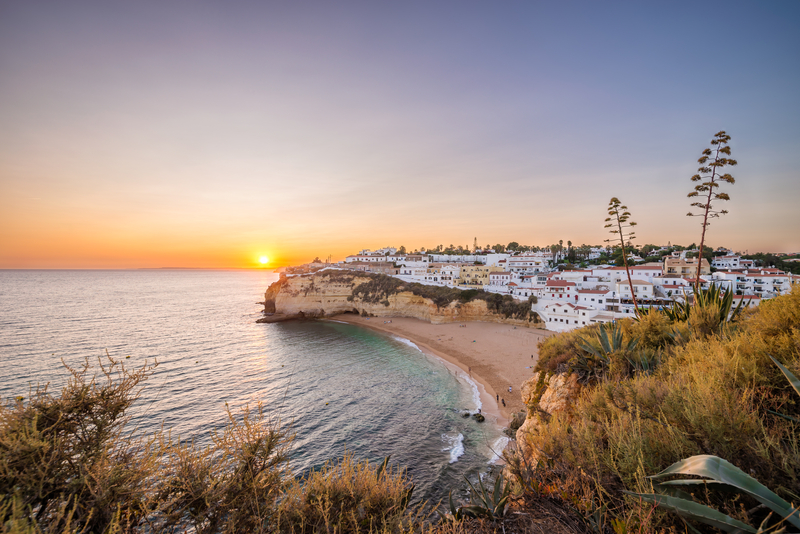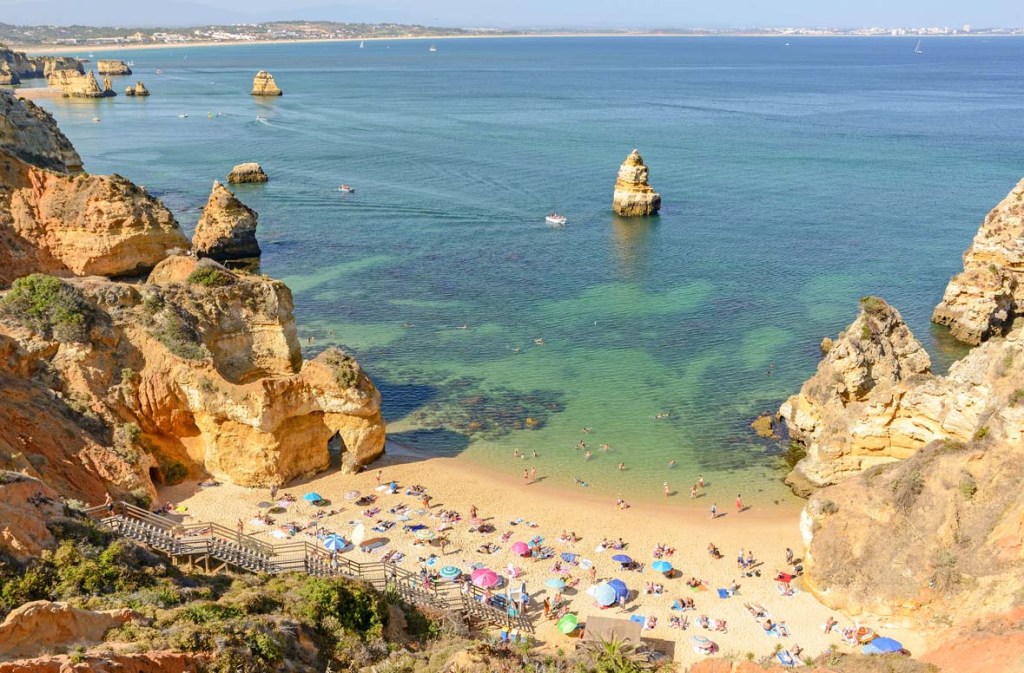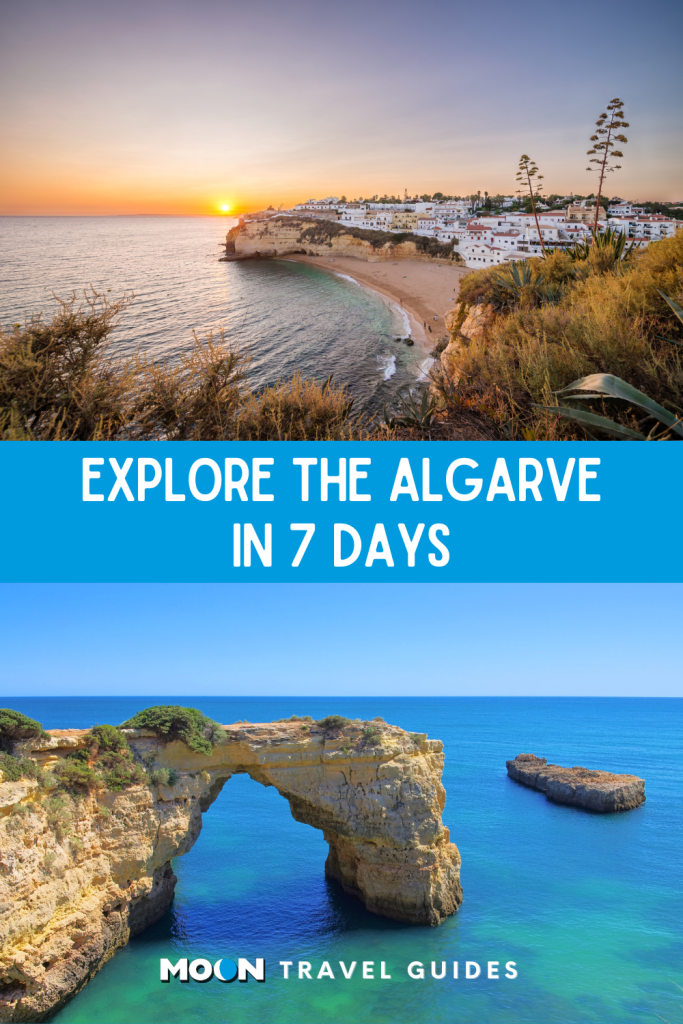Explore the Algarve in 7 Days
The Algarve is Portugal’s number one spot for sun-drenched holidays. Buzzing in summer and beautiful in winter, this year-round destination has stunning stretches of golden sand, crystalline coves, and heady nightlife. Golfers and road trippers flock to the Algarve in winter and spring, when almond trees flourish with snowy white petals. Get started exploring the Algarve with this 7-day itinerary.

Planning Your Visit
Many travelers enter Portugal from neighboring Spain and experience the Algarve from east to west. The eastern Algarve, called the Sotavento, is quiet and unspoiled, largely untouched by mass tourism. The western Algarve, called the Barlavento, has all the comforts tourism offers, including beachside resorts, while retaining plenty of character. Between them is the central Algarve, home to the region’s largest city, Faro.
Two major roads traverse the Algarve, running parallel to one another: the A22 motorway and the N125 national road. Deciding which to use boils down to season and distance. In summer, the N125 becomes heavily congested with holiday traffic. Traffic always flows freely on the A22 motorway, but tolls apply on all stretches, making the N125 more cost-effective for shorter distances.
Train and bus service in the Algarve is regular throughout the day. The CP Algarve train line connects most towns and cities, but not coastal villages. Train stations are often on the outskirts of town, a considerable taxi ride from the town center. Bigger cities have local bus service.
2 Days in Eastern Algarve: The Sotavento
Day 1: Vila Real de Santo António and Tavira
Take the scenic ferry across the Guadiana River from Spain to Vila Real de Santo António. It’s worth spending an hour exploring its pretty town center. After a 1755 earthquake, the town was rebuilt in a distinct Pombaline (Neoclassical) style. See the local lighthouse and walk the palm-tree-fringed riverside, where you can enjoy a coffee while gazing back at Spain. River cruises depart from the marina, ranging from nature-watching trips to party boats.
Soak up the sun on one of Vila Real’s long golden beaches, or at the popular seaside resort of Monte Gordo. Then continue on to the tiny seafront hamlet of Cacela Velha (about a 15-minute drive along the N125), to snack on its famous oysters. End your day at Tavira (a 15-minute drive west on the N125) to enjoy the freshest seafood for dinner before bedding down for the night.
Day 2: Tavira

After breakfast, set out on foot to explore the streets of Tavira. The city straddles the Gilão River, its two sides connected by the ancient Roman Bridge; the main sights are mostly on the western bank. Wander the old town and garden-flanked riverside. Check out the UFO-like camera obscura at Tavira Tower observatory, converted from an old water tower, and the remains of the medieval Tavira Castle. Stop for lunch; many of the local restaurants promote an array of unusual tuna dishes to honor Tavira’s past as a major tuna fishing port.
After lunch, swap land for sea and jump on a ferry boat to Tavira Island. This sandy barrier-island set in the beautiful Ria Formosa lagoon is home to Tavira’s main beach. When you’ve had enough lazing in the sun, head back to Tavira for dinner and slumber.
1 Day in Central Algarve
Day 3: Olhão and Faro
In the morning, head west from Tavira toward Olhão and Faro. Public transport connects the three cities; trains are probably the best way of getting to Faro from the eastern Algarve.
If you’re driving, stop en route at the Pego do Inferno (a 12-minute drive northwest of Tavira via the N270 road), which includes a gorgeous waterfall and lagoon. Fearless visitors jump off the cliffside into the seemingly bottomless turquoise pool.
After you dry off, drive 25 minutes west via the A22 and N398 to Olhão. This fishing town has a distinct North African influence, with cubic, flat-roofed houses. Admire the fresh seafood and local produce at the waterfront market; then head to a nearby café for lunch.
Continue west to genteel Faro (a 20-minute drive west via the N125 road). Spend the afternoon exploring the walled Old Town, climb to the top of the grand Faro Cathedral, and stroll along the riverfront. Take a boat trip to explore the bird-rich Ria Formosa lagoon. Make the most of the city’s varied restaurants and nightlife before turning in for the night.
Newsletter Signup
By clicking ‘Sign Up,’ I acknowledge that I have read and agree to Hachette Book Group’s Privacy Policy and Terms of Use
4 Days in Western Algarve: The Barlavento

Day 4: Carvoeiro and Ferragudo
From Faro, head west toward the charming coastal villages of Carvoeiro and Ferragudo. If traveling by public transport, take the bus from Faro to Lagoa (about 1.5 hours) and then a local bus or taxi from Lagoa bus terminal to Carvoeiro.
If you’re driving, stop en route at the famed pottery shops at Porches on the N125 road (a 40-minute drive from Faro), just before the city of Lagoa. The drive from Porches to Carvoeiro is another 15 minutes via the N125.
In touristy Carvoeiro, stroll the cobbled streets and browse the boutiques before heading to the main square on the beachfront. From Carvoeiro’s main square, walk up the hill to the east to the Algar Seco rock formation and the lovely cliff-top walkway. Or take a grotto trip (around 1 hour) in a traditional wooden fishing boat from Carvoeiro Beach to the astounding Benagil sea cave.
Carvoeiro’s tourist train and the Cliffs Route hop-on, hop-off bus offer options for getting to neighboring Ferragudo, a quintessential Algarve fishing village. Start in the main square by the Arade River and walk up to the Our Lady of the Conception Church. Back along the riverside, take a walk along Ferragudo’s main beach, Praia Grande.
Head back to Carvoeiro to enjoy its colorful bars and restaurants and spend the night.
Day 5: Portimão and Praia da Rocha
Get up early to head to Portimão, the sardine capital of the Algarve (a 20-minute drive west via N125 or 35-minute bus ride). An array of boat trips depart from Portimão’s riverside—there’s even one on a pirate ship. Boat tours usually depart early morning and vary from half-day to full-day excursions. After your cruise, check out the acclaimed Portimão Museum for insight into the city’s canning industry and enjoy lunch and an ice cream on the riverside square.
Head just south of Portimão (a short taxi or shuttle bus ride) to Praia da Rocha, which offers beachside hotels for all budgets and a cliff-top strip of bars and restaurants. Dolphin-watching trips run from the marina and a water taxi crosses the river. Stroll on the wooden walkway along the long, golden beach. Get dressed up for a night on the town.
Day 6: Lagos
Head west to Lagos by car (a 25-minute drive along the N125), or take a train (20 minutes) or bus (35 minutes) from Portimão city center.
Laid-back Lagos is a history buff’s delight. Explore the city’s Old Town Center on foot in the morning, including the elaborate St. Anthony Church, the well-preserved Ponta da Bandeira Fort, and the sobering Slave Market Museum.

Enjoy lunch in one of Lagos’s many backstreet eateries. In the afternoon, walk along postcard-perfect Dona Ana Beach; then continue south to the Ponta da Piedade headland. Boat trips run from the base of the promontory into arches, caves, and grottoes.
In the evening, choose between upscale nightlife at the marina and the bohemian scene in the city center.
Day 7: Sagres
Head west to Sagres by car (a 30-minute drive via the N125) or bus (1 hour).
The most southwesterly tip of mainland Europe, barren Sagres is an area of raw beauty, its soaring cliffs buffeted by huge waves and strong Atlantic winds—which also makes it a top spot for surfing. Retrace the steps of some of Portugal’s most famous explorers as you walk along the dramatic cliffs of Cape St. Vincent and explore the vast Sagres Fortress. Enjoy the sedate but cool vibe of Sagres town, stopping for a bite at one of its inexpensive seafood restaurants.
When you’re ready, head home, whether that means continuing onward to explore the rest of Portugal or returning to Spain. Traveling the entire width of the Algarve without stops takes around two hours on the A22 motorway.
If you have more time…
If you cover Sagres in a morning and have a free afternoon (or an extra day or two), head north up the Algarve’s west coast to Aljezur. From Sagres, the charming market town is a winding 40-minute drive through the unspoiled scenery of the Southwest Alentejo and Vicentine Coast Natural Park. Aljezur’s wild beaches appeal to surfers, motorhomers, and anyone interested in getting off the tourist track.
Start planning your adventure
Newsletter Signup
By clicking ‘Sign Up,’ I acknowledge that I have read and agree to Hachette Book Group’s Privacy Policy and Terms of Use
Build your Europe travel bucket list
Get inspired and get ready for adventure with the ultimate guide to Europe’s best trips!
Pin It for Later



